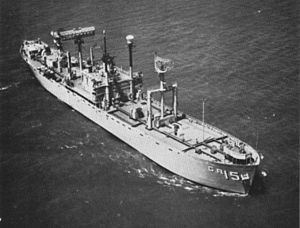Name USS Tracer Launched 31 January 1945 Tons burthen 10.31 million kg | Sponsored by Mrs. Marion Harders Length 134 m Builder Panama City | |
 | ||
Ordered as type (Z-EC2-S-C5) hull, MCE hull 2340 Laid down 24 December 1944, as Liberty ship SS William J. Riddle Acquired by the U.S. Navy, 21 May 1957 Commissioned 16 October 1958 as USS Interrupter (AGR-15) at Charleston Naval Shipyard, Charleston, South Carolina | ||
USS Tracer (AGR-15) – also known as USS Interrupter (AGR-15) – was a Guardian-class radar picket ship acquired by the U.S. Navy in 1957 from the "mothballed" reserve fleet. She was reconfigured as a radar picket ship and assigned to radar picket duty in the North Pacific Ocean as part of the Distant Early Warning Line.
Contents
- Liberty ship built in Panama City Florida
- World War II related service
- Conversion to radar picket ship
- Solving the name problem
- Deactivation
- Honors and awards
- References
Because of the closeness of the sound of names issued for radar picket ships at the time, Interrupter had her name changed by the Navy to Tracer so as not to confuse her with USS Interdictor (AGR-13) and USS Interpreter (AGR-14)
Liberty ship built in Panama City, Florida
William J. Riddle—a "Liberty ship"; -- was laid down under a U.S. Maritime Commission contract (MC hull E-2340) on 24 December 1944 at Panama City, Florida, by the J. A. Jones Construction Co., Inc.; launched on 31 January 1945; sponsored by Mrs. Marion Harders; and, upon completion in early 1945, was delivered to the War Shipping Administration, Maritime Commission.
World War II-related service
William J. Riddle operated with Moore-McCormack Lines and the Waterman Steamship Corporation from 1945 to 1947. When hostilities ended in the Par East in mid-August 1945, the "Liberty ship" was steaming from Hawaii to the Philippines.
Converted to a cattle carrier the following year, she operated as such through the end of 1946. Changed back to a dry cargo carrier by March 1947, she voyaged to European and Mediterranean ports until the summer of 1947 when she was laid up in the U.S. Maritime Commission's National Defense Reserve Fleet and berthed in the James River, Virginia. She remained there for 10 years.
Conversion to radar picket ship
The Navy selected William J. Riddle for conversion to a radar picket ship in May 1957. Towed to the Charleston Naval Shipyard (South Carolina) soon thereafter, conversion work began on 24 May 1957. Renamed Interrupter, and classified as AGR-15, the erstwhile "Liberty" was commissioned at Charleston, South Carolina, 16 October 1958, Lt. Comdr. George S. Harrison in command.
Following shakedown in Guantanamo Bay, Cuba, and post-shakedown availability at her conversion yard, Interrupter sailed for the Pacific Ocean. She transited the Panama Canal on 26 January 1959 and arrived at her home port, San Francisco, California, on 12 February, the sixth AGR to join newly formed Radar Picket Squadron 1.
Fitted out with the latest radar detection equipment, Interrupter and her seven Guardian-class sister ships were designed to serve as the seaborne eyes of the North American Air Defense Command—the naval link in the chain of early-warning stations covering the Pacific approaches to the United States. Her mission was to "detect, report, and track enemy airborne threats approaching by overseas routes and to control the intercepts used to destroy such threats."
Before putting to sea for her first patrol, she conducted training evolutions with U.S. Air Force officers embarked on board for familiarization with the ship's mission. In addition, Interrupter's, officers and men familiarized themselves with the Air Force's part in this vital mission. On 6 March 1959, Interrupter sailed from San Francisco on her first barrier patrol.
Solving the name problem
On 4 September 1959, Interrupter was renamed Tracer to eliminate confusion with some of her sister ships with similarly sounding names.
Between 1959 and 1965, Tracer conducted patrols at sea, at various picket stations in the Western Contiguous Radar Line. The ship proved to be an efficient vessel and received awards for administrative and operational efficiency on several occasions. As more sophisticated early-warning systems came into operational use, the need for the AGR's diminished accordingly.
Deactivation
Deactivated in 1965, Tracer's name was struck from the Navy List on 1 September 1965. She was then transferred to the U.S. Maritime Commission and laid up at Suisun Bay, California, where she remained until sold, 15 July 1974. Before being scrapped in China in 2000, Tracer – renamed Unisea – served as a fish processing plant in Unalaska, Alaska.
Honors and awards
Tracer personnel qualified for the following medal:
